Laravel 10 REST API Authentication using Sanctum Tutorial
Mar 09, 2023 . Admin
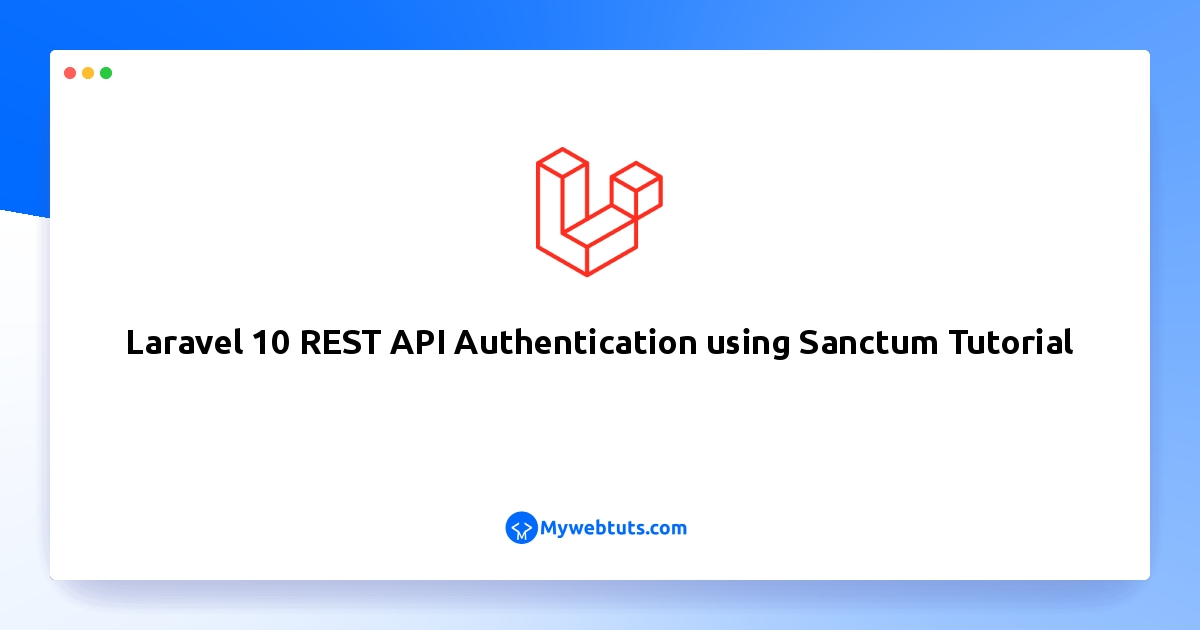
Hi friends,
You will discover how to establish a Laravel 10 REST API using Laravel Sanctum in this example. You will learn how to use Postman to test CRUD (create, read, update, delete) REST APIs and Sanctum authentication in Laravel 10 in addition to other things. It is a straightforward Laravel 10 sanctum example.
You will learn how to develop APIs in Laravel by utilising the Laravel Sanctum package in this Laravel Sanctum API tutorial. Laravel Sanctum authenticates incoming HTTP requests using the Authorization header, which contains the legitimate API token, and saves user API tokens in a single database table.
Step 1: Download LaravelLet us begin the tutorial by installing a new laravel application. if you have already created the project, then skip following step.
composer create-project laravel/laravel example-appStep 2: Use Sanctum
In this step we need to install sanctum via the Composer package manager, so one your terminal and fire bellow command:
composer require laravel/sanctum
After successfully install package, we need to publish configuration file with following command:
php artisan vendor:publish --provider="Laravel\Sanctum\SanctumServiceProvider"
we require to get default migration for create new sanctum tables in our database. so let's run bellow command.
php artisan migrate
Next, we need to add middleware for sanctum api, so let's add as like bellow:
....
'api' => [
\Laravel\Sanctum\Http\Middleware\EnsureFrontendRequestsAreStateful::class,
'throttle:api',
\Illuminate\Routing\Middleware\SubstituteBindings::class,
],
....
Step 3: Sanctum Configuration
In this step, we have to configuration on three place model, service provider and auth config file. So you have to just following change on that file.
In model we added HasApiTokens class of Sanctum,
In auth.php, we added api auth configuration.
app/Models/User.php
<?php
namespace App\Models;
use Illuminate\Contracts\Auth\MustVerifyEmail;
use Illuminate\Database\Eloquent\Factories\HasFactory;
use Illuminate\Foundation\Auth\User as Authenticatable;
use Illuminate\Notifications\Notifiable;
use Laravel\Sanctum\HasApiTokens;
class User extends Authenticatable
{
use HasFactory, Notifiable, HasApiTokens;
/**
* The attributes that are mass assignable.
*
* @var array
*/
protected $fillable = [
'name',
'email',
'password',
];
/**
* The attributes that should be hidden for arrays.
*
* @var array
*/
protected $hidden = [
'password',
'remember_token',
];
/**
* The attributes that should be cast to native types.
*
* @var array
*/
protected $casts = [
'email_verified_at' => 'datetime',
];
}
Step 4: Add Post Table and Model
next, we require to create migration for posts table using Laravel 10 php artisan command, so first fire bellow command:
php artisan make:migration create_posts_table
After this command you will find one file in following path database/migrations and you have to put bellow code in your migration file for create posts table.
<?php
use Illuminate\Database\Migrations\Migration;
use Illuminate\Database\Schema\Blueprint;
use Illuminate\Support\Facades\Schema;
return new class extends Migration
{
/**
* Run the migrations.
*
* @return void
*/
public function up()
{
Schema::create('posts', function (Blueprint $table) {
$table->id();
$table->string('title');
$table->text('body');
$table->timestamps();
});
}
/**
* Reverse the migrations.
*
* @return void
*/
public function down()
{
Schema::dropIfExists('posts');
}
};
After create migration we need to run above migration by following command:
php artisan migrate
After create "posts" table you should create Post model for posts, so first create file in this path app/Models/Post.php and put bellow content in item.php file:
app/Models/Post.php
<?php
namespace App\Models;
use Illuminate\Database\Eloquent\Factories\HasFactory;
use Illuminate\Database\Eloquent\Model;
class Post extends Model
{
use HasFactory;
/**
* The attributes that are mass assignable.
*
* @var array
*/
protected $fillable = [
'title', 'body'
];
}
Step 5: Add API Routes
In this step, we will create api routes for login, register and posts rest api. So, let's add new route on that file.
routes/api.php
<?php
use Illuminate\Http\Request;
use Illuminate\Support\Facades\Route;
use App\Http\Controllers\API\RegisterController;
use App\Http\Controllers\API\PostController;
/*
|--------------------------------------------------------------------------
| API Routes
|--------------------------------------------------------------------------
|
| Here is where you can register API routes for your application. These
| routes are loaded by the RouteServiceProvider within a group which
| is assigned the "api" middleware group. Enjoy building your API!
|
*/
Route::controller(RegisterController::class)->group(function(){
Route::post('register', 'register');
Route::post('login', 'login');
});
Route::middleware('auth:sanctum')->group( function () {
Route::resource('posts', PostController::class);
});
Step 6: Add Controller Files
in next step, now we have create new controller as BaseController, PostController and RegisterController, i created new folder "API" in Controllers folder because we will make alone APIs controller, So let's create both controller:
php artisan make:controller BaseControllerapp/Http/Controllers/API/BaseController.php
<?php
namespace App\Http\Controllers\API;
use Illuminate\Http\Request;
use App\Http\Controllers\Controller as Controller;
class BaseController extends Controller
{
/**
* success response method.
*
* @return \Illuminate\Http\Response
*/
public function sendResponse($result, $message)
{
$response = [
'success' => true,
'data' => $result,
'message' => $message,
];
return response()->json($response, 200);
}
/**
* return error response.
*
* @return \Illuminate\Http\Response
*/
public function sendError($error, $errorMessages = [], $code = 404)
{
$response = [
'success' => false,
'message' => $error,
];
if(!empty($errorMessages)){
$response['data'] = $errorMessages;
}
return response()->json($response, $code);
}
}
php artisan make:controller RegisterControllerapp/Http/Controllers/API/RegisterController.php
<?php
namespace App\Http\Controllers\API;
use Illuminate\Http\Request;
use App\Http\Controllers\API\BaseController as BaseController;
use App\Models\User;
use Illuminate\Support\Facades\Auth;
use Validator;
class RegisterController extends BaseController
{
/**
* Register api
*
* @return \Illuminate\Http\Response
*/
public function register(Request $request)
{
$validator = Validator::make($request->all(), [
'name' => 'required',
'email' => 'required|email',
'password' => 'required',
]);
if($validator->fails()){
return $this->sendError('Validation Error.', $validator->errors());
}
$input = $request->all();
$input['password'] = bcrypt($input['password']);
$user = User::create($input);
$success['token'] = $user->createToken('MyApp')->plainTextToken;
$success['name'] = $user->name;
return $this->sendResponse($success, 'User register successfully.');
}
/**
* Login api
*
* @return \Illuminate\Http\Response
*/
public function login(Request $request)
{
if(Auth::attempt(['email' => $request->email, 'password' => $request->password])){
$user = Auth::user();
$success['token'] = $user->createToken('MyApp')->plainTextToken;
$success['name'] = $user->name;
return $this->sendResponse($success, 'User login successfully.');
}
else{
return $this->sendError('Unauthorised.', ['error'=>'Unauthorised']);
}
}
}
php artisan make:controller PostControllerapp/Http/Controllers/API/PostController.php
<?php
namespace App\Http\Controllers\API;
use Illuminate\Http\Request;
use App\Http\Controllers\API\BaseController as BaseController;
use App\Http\Resources\PostResource;
use App\Models\Post;
use Validator;
class PostController extends BaseController
{
/**
* Display a listing of the resource.
*
* @return \Illuminate\Http\Response
*/
public function index()
{
$posts = Post::all();
return $this->sendResponse(PostResource::collection($posts), 'Post retrieved successfully.');
}
/**
* Store a newly created resource in storage.
*
* @param \Illuminate\Http\Request $request
* @return \Illuminate\Http\Response
*/
public function store(Request $request)
{
$input = $request->all();
$validator = Validator::make($input, [
'title' => 'required',
'body' => 'required'
]);
if($validator->fails()){
return $this->sendError('Validation Error.', $validator->errors());
}
$post = Post::create($input);
return $this->sendResponse(new PostResource($post), 'Post created successfully.');
}
/**
* Display the specified resource.
*
* @param int $id
* @return \Illuminate\Http\Response
*/
public function show($id)
{
$post = Post::find($id);
if (is_null($post)) {
return $this->sendError('Post not found.');
}
return $this->sendResponse(new PostResource($post), 'Post retrieved successfully.');
}
/**
* Update the specified resource in storage.
*
* @param \Illuminate\Http\Request $request
* @param int $id
* @return \Illuminate\Http\Response
*/
public function update(Request $request, Post $post)
{
$input = $request->all();
$validator = Validator::make($input, [
'title' => 'required',
'body' => 'required'
]);
if($validator->fails()){
return $this->sendError('Validation Error.', $validator->errors());
}
$post->title = $input['title'];
$post->body = $input['body'];
$post->save();
return $this->sendResponse(new PostResource($post), 'Post updated successfully.');
}
/**
* Remove the specified resource from storage.
*
* @param int $id
* @return \Illuminate\Http\Response
*/
public function destroy(Post $post)
{
$post->delete();
return $this->sendResponse([], 'Post deleted successfully.');
}
}
Step 7: Add Eloquent API Resources
This is a very important step of creating rest api in laravel 10. you can use eloquent api resources with api. it will helps you to make same response layout of your model object. we used in PostController file. now we have to create it using following command:
php artisan make:resource PostResource
Now there created new file with new folder on following path:
app/Http/Resources/PostResource.php
<?php
namespace App\Http\Resources;
use Illuminate\Http\Resources\Json\JsonResource;
class PostResource extends JsonResource
{
/**
* Transform the resource into an array.
*
* @param \Illuminate\Http\Request $request
* @return array
*/
public function toArray($request)
{
return [
'id' => $this->id,
'title' => $this->title,
'body' => $this->body,
'created_at' => $this->created_at->format('d/m/Y'),
'updated_at' => $this->updated_at->format('d/m/Y'),
];
}
}
Run Laravel App:
All steps have been done, now you have to type the given command and hit enter to run the laravel app:
php artisan serve
Now, you have to open web browser, type the given URL and view the app output:
'headers' => [
'Accept' => 'application/json',
'Authorization' => 'Bearer '.$accessToken,
]
Here is Routes URL with Verb:
Now simply you can run above listed url like as bellow screen shot:
1. Register API: Verb:GET, URL:http://localhost:8000/api/register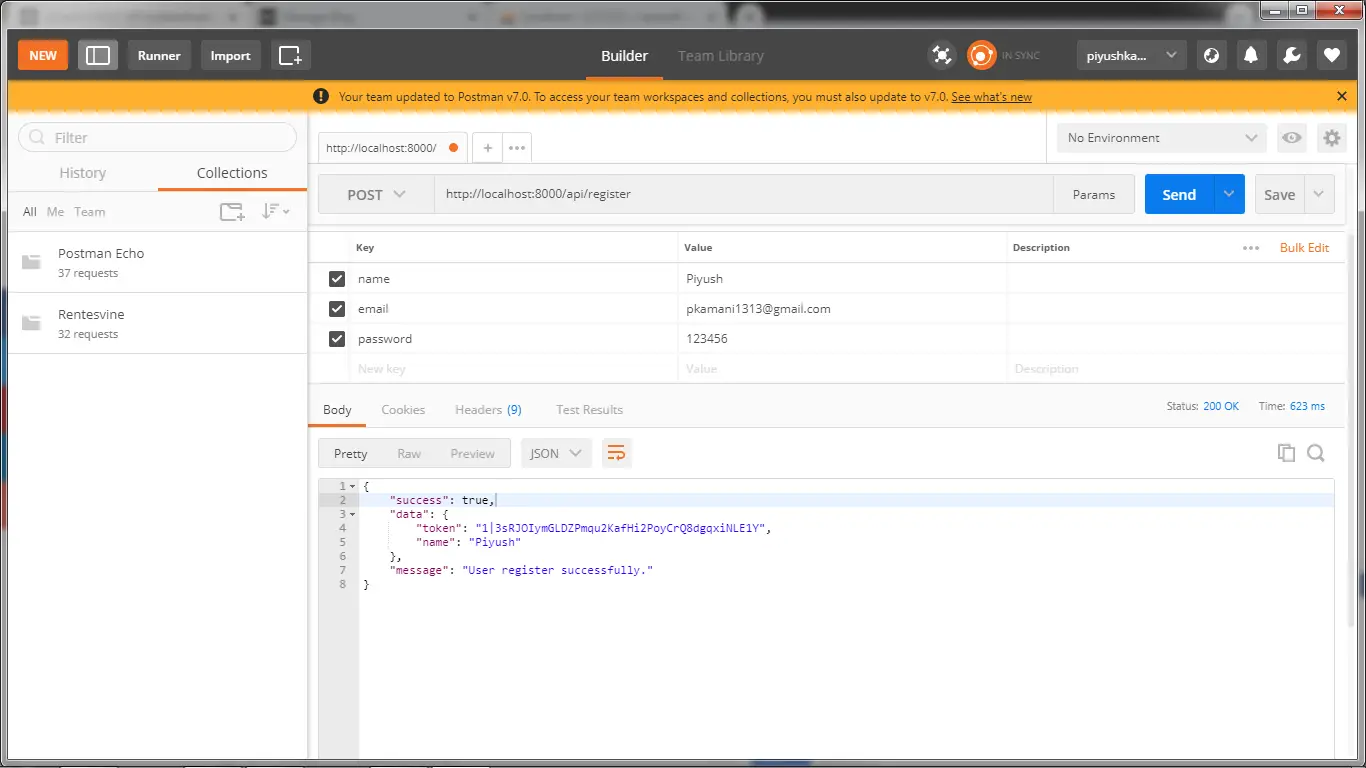 2. Login API: Verb:GET, URL:http://localhost:8000/api/login
2. Login API: Verb:GET, URL:http://localhost:8000/api/login
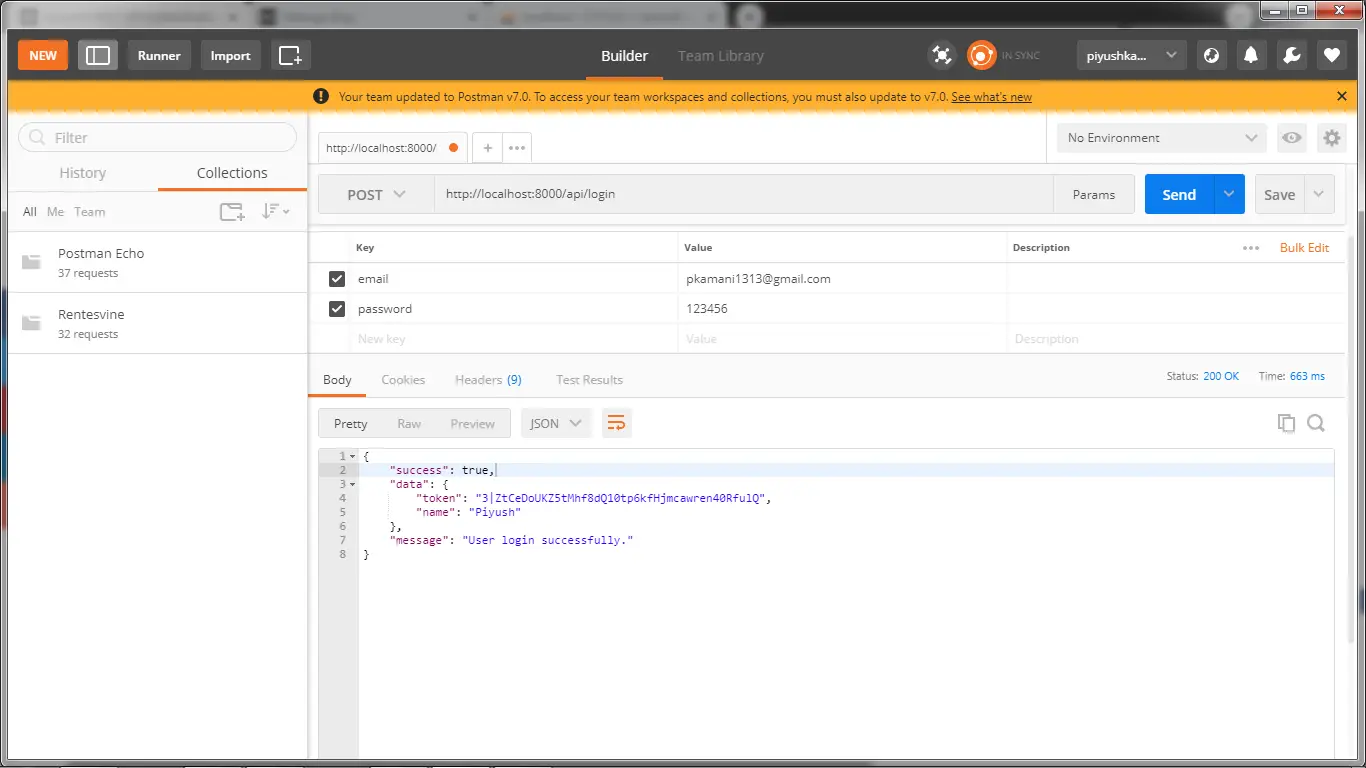 3. Post List API: Verb:GET, URL:http://localhost:8000/api/posts
3. Post List API: Verb:GET, URL:http://localhost:8000/api/posts
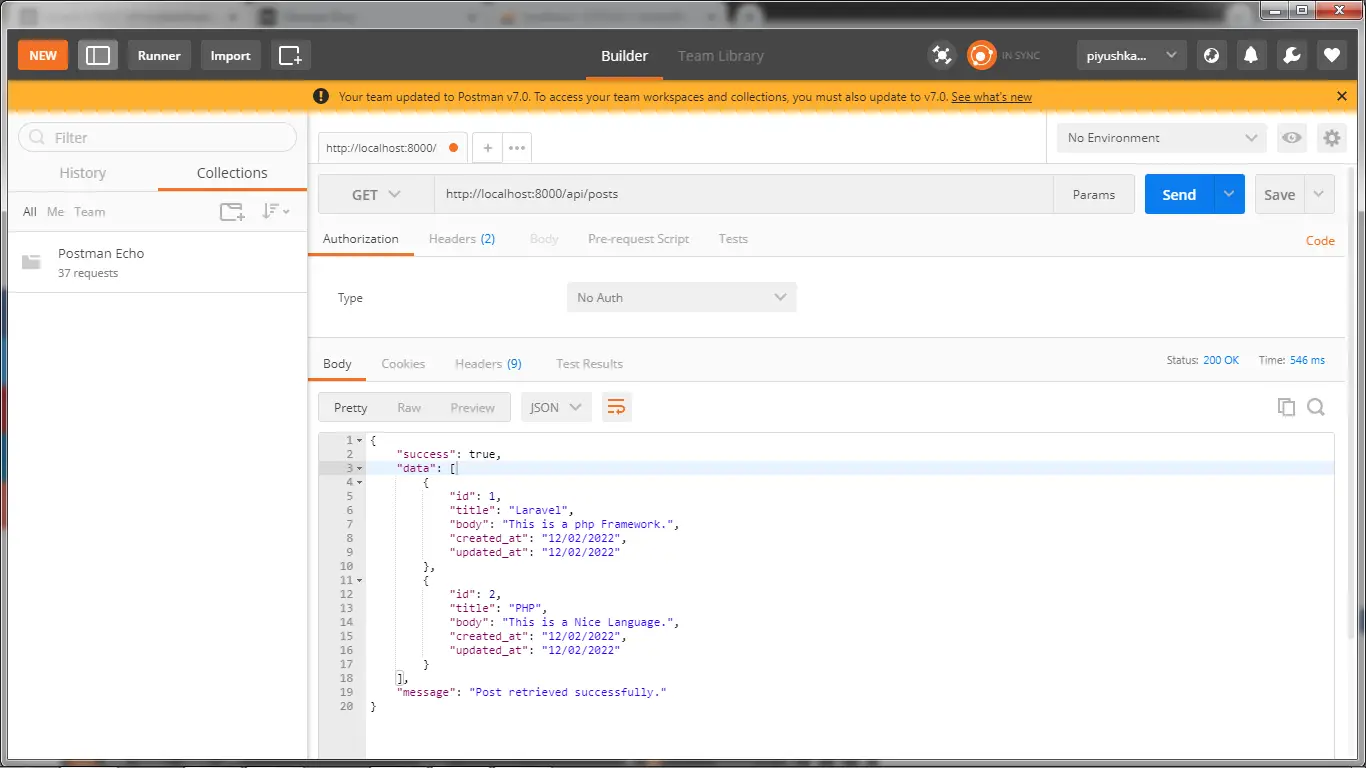 4. Post Create API: Verb:GET, URL:http://localhost:8000/api/posts
4. Post Create API: Verb:GET, URL:http://localhost:8000/api/posts
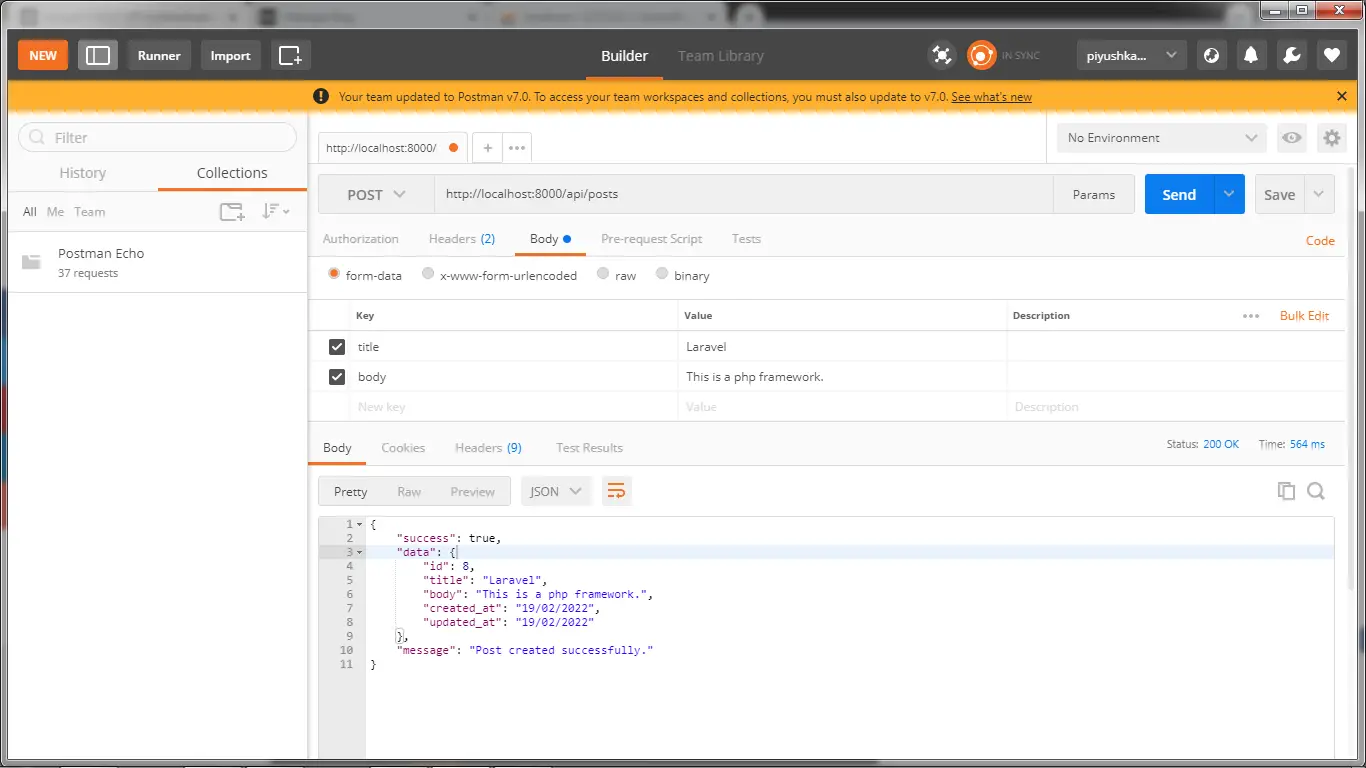 5. Post Show API: Verb:GET, URL:http://localhost:8000/api/posts/{id}
5. Post Show API: Verb:GET, URL:http://localhost:8000/api/posts/{id}
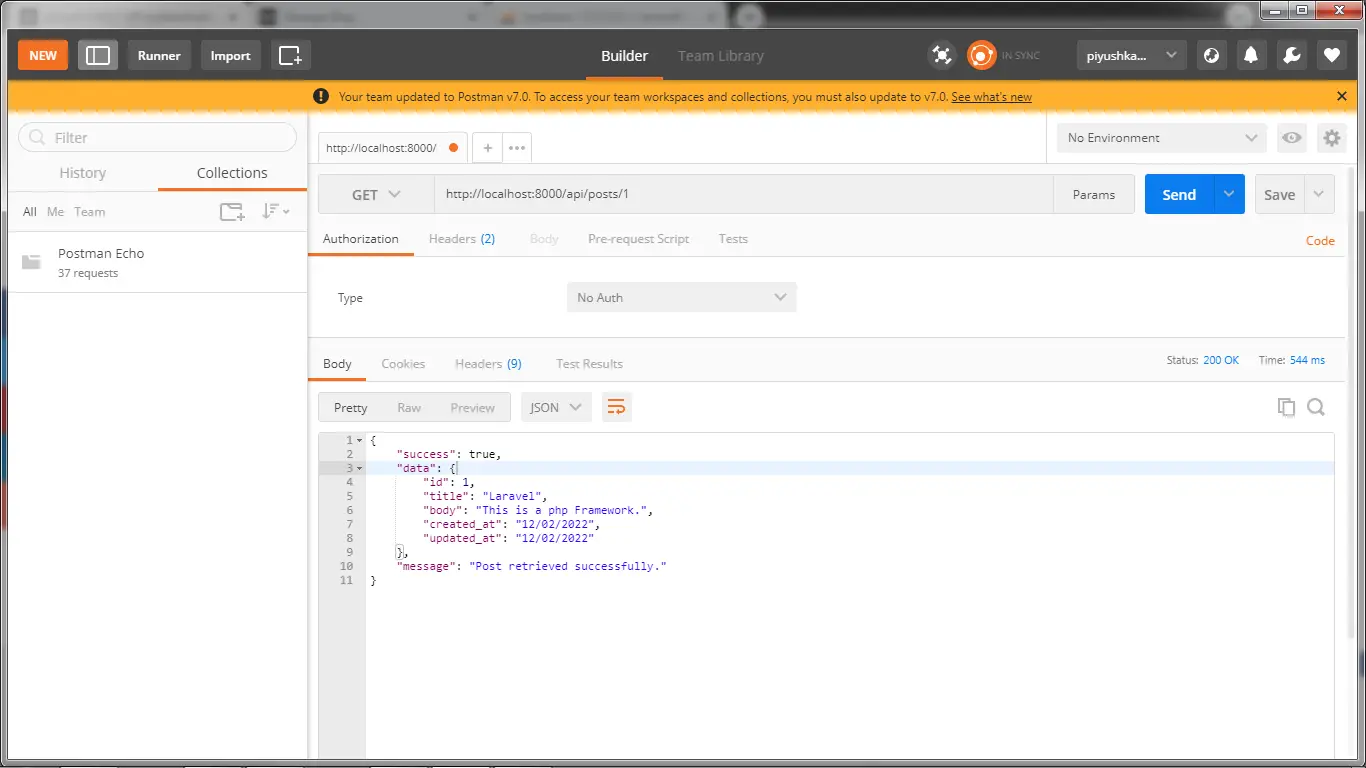 6. Post Update API: Verb:PUT, URL:http://localhost:8000/api/posts/{id}
6. Post Update API: Verb:PUT, URL:http://localhost:8000/api/posts/{id}
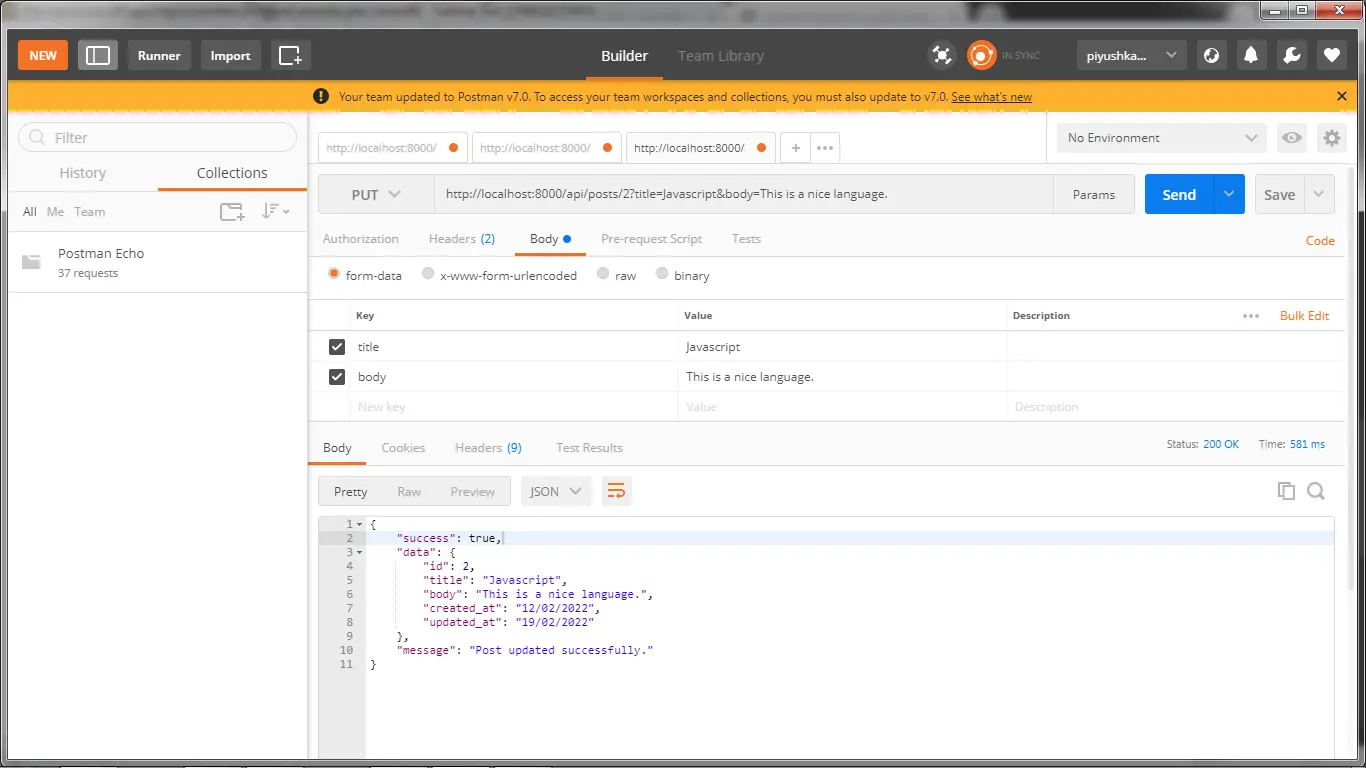 7. Post Delete API: Verb:DELETE, URL:http://localhost:8000/api/posts/{id}
7. Post Delete API: Verb:DELETE, URL:http://localhost:8000/api/posts/{id}
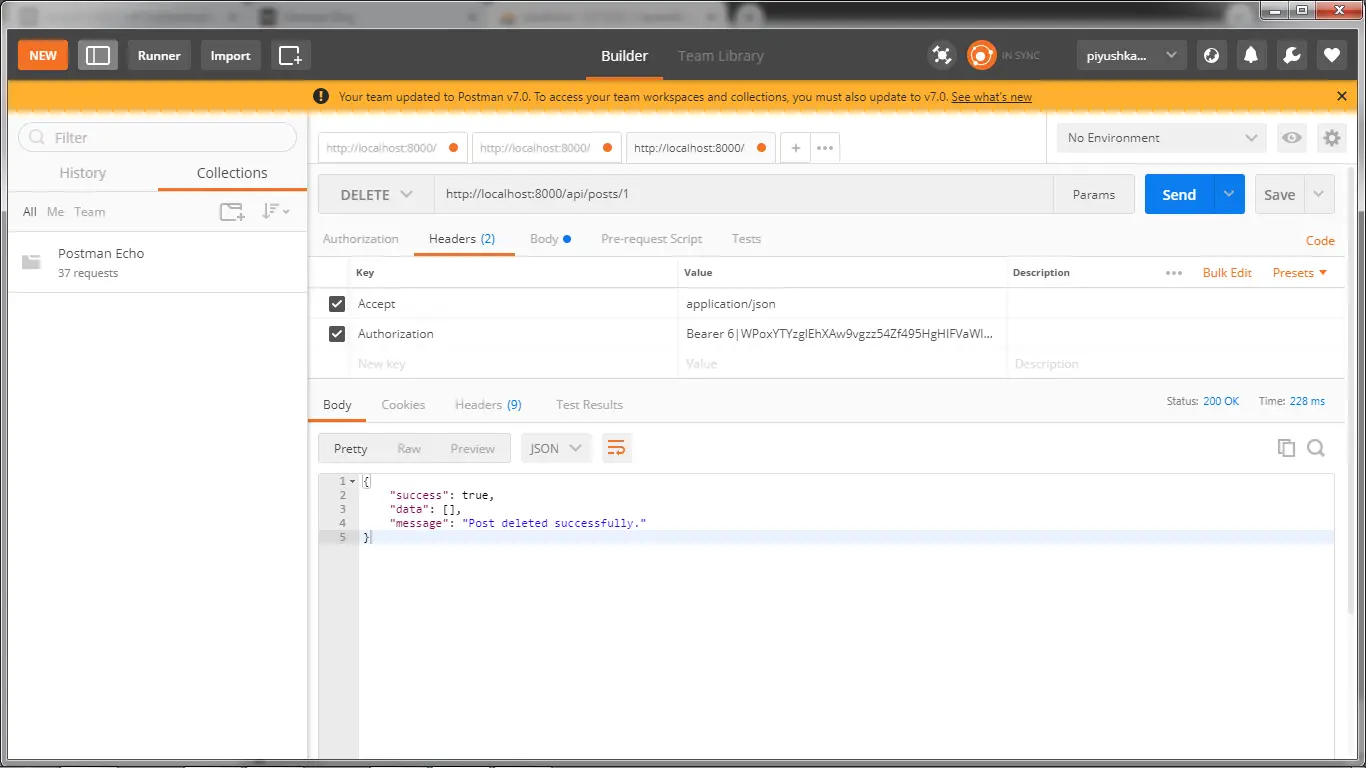
I hope it can help you...
